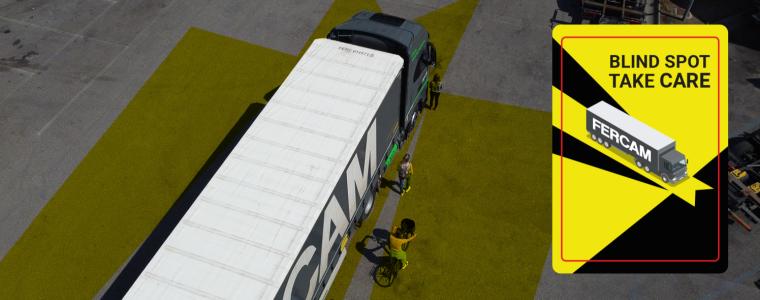
9 August 2021 - by: Silvia Pedrotti
Blind spot: a danger to be aware of
Blind spot areas are a deeply felt and debated topic in the world of transport. Especially in cities, commercial vehicles turning right pose a great danger to pedestrians and cyclists. Let's find out about new European Directives and new technologies that aim at guaranteeing better safety for all road users.

How is a blind spot generated?
As we all know, heavy vehicles are not always able to see pedestrians and cyclists passing sideways, due to the numerous "blind spots" caused by the size of the vehicle. The driver is, in fact, in a very high position with respect to the road surface: the eye line is 3 meters or more from the ground and, although a vehicle is equipped with 2-3 rear-view mirrors in the cabin, these cannot replace direct vision: a small adjustment error is enough to leave a large dead spot in the driver's vision. To aggravate the picture, the right side can only be controlled with rear-view mirrors, while on the left side the driver is able to see more only by moving closer to the window. It is precisely when the vehicle is turning right that weak users are more in danger, as they are at risk of easily entering a dead corner, outside the driver’s visibility range.European anti Blind Spot regulatory developments
The European Directive 2007/38/EC, which introduced the obligation to mount specific mirrors for the blind spot on commercial vehicles, had the goal to save the lives of 1,200 people by 2020. A few years have passed and not all commercial vehicles are yet equipped with these mirrors. From 2024, the new EU Directive will require the fitting of ADAS systems to “illuminate” blind spots on newly approved vehicles, thus reducing the risk of hitting cyclists or pedestrians when turning. This obligation will also be extended to all vehicles circulating in Europe.Pending this constraint, some states have taken action in advance by creating ad-hoc regulations: this is the case of the United Kingdom and France. With the Direct Vision Standard (DVS) decree launched by the Transport for London, starting from last October 26, 2020, all freight vehicles weighing more than 12 tons, including those coming from abroad, require a permit to enter and circulate in the Greater London; permit issued only to vehicles equipped with cameras, anti-blind spot sensors and warning stickers for pedestrians.
Since last February, France has also passed national legislation that affects all vehicles weighing more than 3.5 tons, which provides for the mandatory posting of black and yellow reflective stickers on the rear and side of trucks. Starting from 1 July last, the lack of these stickers is punishable by law.
What are the new technological advancements?
Manufacturers are also particularly active in developing innovative blind spot monitoring systems. To name a few turning assistance systems, MAN introduced the VAS, Peugeot the Surround Rear Vision, Daf the DVS Safe System and Scania the VRUCW.FERCAM, which has always been sensitive to the issue of safety, chose to take advantage of the new MirrorCams of the Daimler Actros and to equip the IVECO LNG fleet with the DVS kit from Brigade Ltd. In the first case, cameras completely replace the rear-view mirrors providing an enlarged view and flashing signals directly visible from the cab monitor; in the second, the cameras are added to the rear-view mirrors and, in addition to detecting the presence of objects and users visually, they have a sound alert system, audible both inside and outside the passenger compartment.
Tutorial: how to avoid the blind spot
Vehicle camera systems are a big step up from the many rear-view mirrors otherwise needed to monitor blind spots; common sense and prudence, however, are always necessary allies of road safety. Many people, in fact, do not have the slightest suspicion of how limited the lateral visibility of the road can be for a heavy vehicle and that the larger the vehicle, the more extensive the blind spots. Keeping a good distance from all vehicles, especially large ones where the driver is unlikely to see us, is an excellent starting strategy. Here are some practical tips:- First of all make eye contact with the driver, then cross the street.
- Always keep in mind that if you cannot see the driver, most likely he will not be able to see us either.
- Remember that it is safer to stay behind the truck than to the side.
- If you are on the side, keep a large distance from the vehicle.

Share


 Language
Language

























